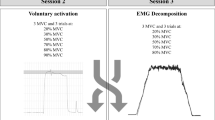Summary
Using a combination of single maximal stimuli and maximum voluntary contractions, a comparison has been made of muscle properties in pre- and post-pubertal male subjects. In the dorsiflexor and plantarflexor muscles of the ankle, the twitch and maximum voluntary torques were approximately twice as large in the older subjects; the mean height and mean weight increased by factors of 1.20 and 1.86 respectively. The only other muscle parameter that changed, as a function of age, was the contraction time of the ankle dorsiflexors; the mean value was significantly longer in the older subjects. In the younger subjects, there were already clear differences between the dorsiflexor and plantarflexor muscles, the former developing smaller torques and having shorter contraction and half-relaxation times, greater post-activation potentiation and more susceptibility to fatigue. Even in the youngest subject, motor unit activation was complete in the ankle dorsiflexors; although this was not always true of the plantarflexors, the difference between the two subject groups was not significant.
Similar content being viewed by others
References
Anderson M, Blais M, Green WT (1956) Growth of the normal foot during childhood and adolescence. Length of the foot and interrelations of foot, stature and lower extremity as seen in serial records of children between 1–18 years of age. Am J Phys Anthropol 14:287–308
Asmussen E, Heeboll-Nillson K, Molbelch SV (1959) Description of muscle tests and standard values of muscle strength in children. Communication, testing and observation. Institute Danish National Association for Infantile Paralysis, [Suppl] 5:1–59
Belanger AY, McComas AJ (1981) Extent of motor unit activation during effort. J Appl Physiol: Respirat Environ Exerc Physiol 51:1131–1135
Belanger AY, McComas AJ, Elder GBC (1983) Physiological properties of two antagonistic human muscle groups. Eur J Appl Physiol 51:381–393
Buller AJ, Eccles JC, Eccles RM (1960) Differentiation of fast and slow muscles in the cat hindlimb. J Physiol 150:399–416
Clark HH (1971) Physical and motor tests in the Medford Boy's Growth Study. Prentice-Hall. Englewood Cliffs
Davies CTM, White MJ, Young K (1983) Muscle function in children. Eur J Appl Physiol 52:111–114
Dubowitz V (1965) Enzyme histochemistry of skeletal muscle. J Neurol Neurosurg Psychiatry 28:516–524
Elder GCB (1979) The metabolic differentiation of human skeletal muscle during foetal and postnatal development. PhD Thesis, McMaster University, Hamilton, p 215
Gatev V, Stamatova L, Angelova B (1977) Contraction time in skeletal muscles of normal children. Electromyogr Clin Neurophysiol 17:441–452
Hedberg G, Jansson E (1976) Skeletal muscle distribution, capacity and interest in different physical activities among students in High School. Pedagogisca rapporter, Umea
Hosking GP, Young A, Dubowitz V, Edwards RHT (1978) Tests of skeletal muscle function in children. Arch Dis Child 53:224–229
Jones HE (1949) Motor Performance and Growth: Development and Study of Static Dynamometric Strength. Univ of California Press, Berkely
Keogh J, Sugden D (1985) Anthropometric correlates of strength and motor performance. In: Wilmore JH, Keogh JF (eds) Exerc Sport Sci Rev. Academic Press, New York
Malina RM (1975) Anthropometric correlates of strength and motor performance. In: Wilmore JH, Keogh JF (eds). Exerc Sport Sci Rev. Academic Press, New York
Marsh E, Sale D, McComas AJ, Quinlan J (1981) Influence of joint position on ankle dorsiflexion in humans. J Appl Physiol: Respirat Environ Exerc Physiol 51:160–167
McComas AJ, Sica REP, Petito F (1973) Muscle strength in boys of different ages. J Neurol Neurosurg Psychiatr 36:171–173
Moore RL, Stull JJ (1984) Myosin light chain phosphorylation in fast and slow skeletal muscles in situ. Am J Physiol 247:C462-C471
Sale D, Quinlan J, Marsh E, McComas AJ (1982) Influence of joint position on ankle plantarflexion in humans. J Appl Physiol: Respir Environ Exerc Physiol 52:1636–1642
Vandervoort AA, McComas AJ (1986) Contractile changes in opposing muscle of the human ankle joint with aging. J Appl Physiol 61:361–367
Author information
Authors and Affiliations
Additional information
Supported by the Muscular Dystrophy Association of Canada
Rights and permissions
About this article
Cite this article
Belanger, A.Y., McComas, A.J. Contractile properties of human skeletal muscle in childhood and adolescence. Europ. J. Appl. Physiol. 58, 563–567 (1989). https://doi.org/10.1007/BF00418500
Accepted:
Issue Date:
DOI: https://doi.org/10.1007/BF00418500




